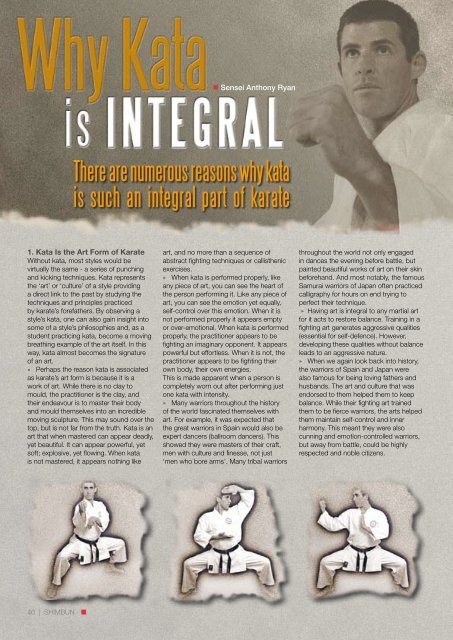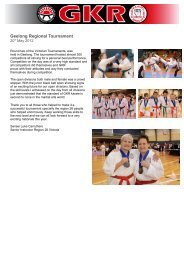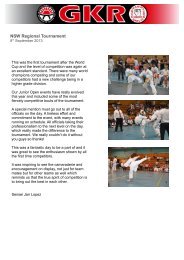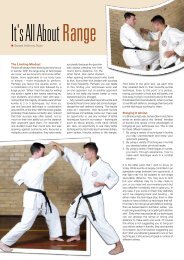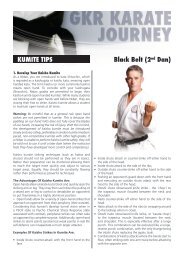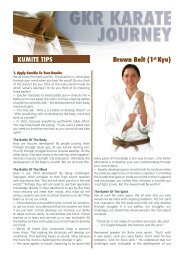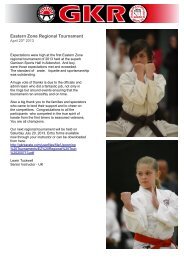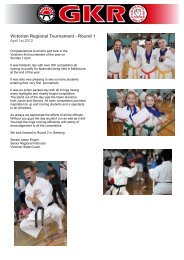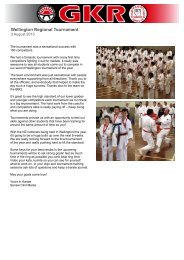Training3_kata 06_3.pdf - GKR Karate
Training3_kata 06_3.pdf - GKR Karate
Training3_kata 06_3.pdf - GKR Karate
- No tags were found...
Create successful ePaper yourself
Turn your PDF publications into a flip-book with our unique Google optimized e-Paper software.
• Sensei Anthony RyanThere are numerous reasons why <strong>kata</strong>is such an integral part of karate1. Kata Is the Art Form of <strong>Karate</strong>Without <strong>kata</strong>, most styles would bevirtually the same - a series of punchingand kicking techniques. Kata representsthe ‘art’ or ‘culture’ of a style providinga direct link to the past by studying thetechniques and principles practicedby karate’s forefathers. By observing astyle’s <strong>kata</strong>, one can also gain insight intosome of a style’s philosophies and, as astudent practicing <strong>kata</strong>, become a movingbreathing example of the art itself. In thisway, <strong>kata</strong> almost becomes the signatureof an art.» Perhaps the reason <strong>kata</strong> is associatedas karate’s art form is because it is awork of art. While there is no clay tomould, the practitioner is the clay, andtheir endeavour is to master their bodyand mould themselves into an incrediblemoving sculpture. This may sound over thetop, but is not far from the truth. Kata is anart that when mastered can appear deadly,yet beautiful. It can appear powerful, yetsoft; explosive, yet flowing. When <strong>kata</strong>is not mastered, it appears nothing likeart, and no more than a sequence ofabstract fighting techniques or callisthenicexercises.» When <strong>kata</strong> is performed properly, likeany piece of art, you can see the heart ofthe person performing it. Like any piece ofart, you can see the emotion yet equally,self-control over this emotion. When it isnot performed properly it appears emptyor over-emotional. When <strong>kata</strong> is performedproperly, the practitioner appears to befighting an imaginary opponent. It appearspowerful but effortless. When it is not, thepractitioner appears to be fighting theirown body, their own energies.This is made apparent when a person iscompletely worn out after performing justone <strong>kata</strong> with intensity.» Many warriors throughout the historyof the world fascinated themselves withart. For example, it was expected thatthe great warriors in Spain would also beexpert dancers (ballroom dancers). Thisshowed they were masters of their craft,men with culture and finesse, not just‘men who bore arms’. Many tribal warriorsthroughout the world not only engagedin dances the evening before battle, butpainted beautiful works of art on their skinbeforehand. And most notably, the famousSamurai warriors of Japan often practicedcalligraphy for hours on end trying toperfect their technique.» Having art is integral to any martial artfor it acts to restore balance. Training in afighting art generates aggressive qualities(essential for self-defence). However,developing these qualities without balanceleads to an aggressive nature.» When we again look back into history,the warriors of Spain and Japan werealso famous for being loving fathers andhusbands. The art and culture that wasendorsed to them helped them to keepbalance. While their fighting art trainedthem to be fierce warriors, the arts helpedthem maintain self-control and innerharmony. This meant they were alsocunning and emotion-controlled warriors,but away from battle, could be highlyrespected and noble citizens.40 | SHIMBUN
» The warriors of other countries whooften painted their faces and bodies anddanced before battle were also noted ashaving loving qualities. In many respects,the face painting was about creating amask and symbolised an alter ego beingcreated solely for battle. This way theycould be two people, a warrior and acitizen, but both were different people soone did not disrupt the life of the other.» In comparison, countries throughouthistory whose warriors trained in fightingarts without any promotion of art or cultureoften struggled to keep balance, unableto separate the warrior from the man.Away from battle, warriors would oftentake women against their will, were rudeand obnoxious and often misused theirskills. They also failed to fit into society,something many war veterans feel from themore modern wars.2. Kata Teaches Self-DefenceAs well as an art form, <strong>kata</strong> is also aform of self-defence training. Commonlydescribed as a fight scene againstimaginary attackers, each technique orcombination of techniques within a <strong>kata</strong>has a bunkai (application) based on aself-defence scenario. At times the selfdefenceapplications are easily recognised,while some require slight explanationbefore becoming apparent.» What has frustrated thoseunappreciative of <strong>kata</strong> and led to theirlabelling it as no more than an art formand an ineffective means of self-defence,is the fact that many <strong>kata</strong> applicationsare very abstract, while others required‘added’ techniques (like a jigsaw) beforethe technique becomes ‘effective’ andapparent. There are three major influencesbehind <strong>kata</strong> having a sense of ‘mysterythat needs to be unlocked’.» Firstly, and perhaps the mostunderstandable, is that karate’s forefathersoriginally created <strong>kata</strong> with deliberateintention to conceal their self-defenceapplication. This served to prevent casualobservers, or those who were not seriousabout learning all things involved withkarate (such as the time it takes to develophumility etc) from learning potentiallydeadly techniques.» The second major influence camein 1901 when Master Yasutsune Itosuintroduced karate into the Japaneseschool system. He believed that <strong>kata</strong> wastoo dangerous to be taught to youngchildren so he set about disguising manyof the techniques inside.» The third major influence came dueto the fact that <strong>kata</strong> mostly dealt withdefence from being grappled and assuch, contained numerous highly effectivetechniques such as eye-gouging, throatgrabbing, groin squeezing etc. Thesetechniques were known as entrancetechniques. However when karate arrivedfrom Okinawa, the Japanese believed itto be ‘too violent’, therefore resulting ina number of these entrance techniquesbeing removed. Understanding that<strong>kata</strong> had a number of these entrancetechniques removed helps to illuminate thereal potential of <strong>kata</strong>. For example: Whenstudying bunkai, a person will discover thatalmost all <strong>kata</strong> have a number of defencesagainst a ‘wrist grab’. Again, some <strong>kata</strong>critics make a point that it is extremely rarefor an attacker to start by grabbing theirvictim’s wrist.» What must be understood however, isthat if our first reaction were an entrancetechnique (such as the seizing theattacker’s eyes, throat or groin), their likelyreaction would be to try and remove yourgrip (hence grabbing your wrist). From thisposition it suddenly becomes apparent theadvantage of knowing a number of waysto either remove or reverse a wrist grab.Equally, by understanding that the attackerhas not just grabbed your wrist for noreason, and that the philosophy is for youto have control, or part control of one oftheir vital areas, the attacker will have lessstrength in their arm, making it believablethat a weaker person could execute thetechnique effectively.» By understanding, and even visualisingthe bunkai (application) of the techniqueswhile performing <strong>kata</strong>, practitioners equipthemselves for a self-defence situation by:• They gain insight into various defencesagainst numerous situations (defenceagainst both striking and grapplingattacks).• They gain muscle memory of how tomove when fighting numerous attackers(such as changing between stances toremain balanced and strong, andchanging angles).• It trains a person to execute theirtechniques with full spirit and kime.To land their techniques perfectlywithout fear of hurting their opponent(sparring often fails to endorse this).Some practitioners proclaim that sparringis modern karate’s best training forself-defence. While it is absolute thatsparring is important for self-defencetraining by developing timing, distanceand a familiarity with the mental andphysical ramifications of being attacked,all practitioners are limited without <strong>kata</strong>training. This is because sparring followsa set of rules, a designated distance andrarely involves being grappled or surprised.3. Kata Promotes Self-masteryIs <strong>kata</strong> entirely essential? A tool fordeveloping self-defence skills andideologies? <strong>Karate</strong>’s art, and an historicallink to its past?SHIMBUN | 41
W h y K a t a I s I n t e g r a lIt could be proposed that each of thesecould be developed by numerous means.Students can, and do learn self-defenceduring basics, sparring and specific selfdefencedrills. And the history of karate canbe preserved through studying its history.So perhaps the most potent tool that <strong>kata</strong>equips a student with, is the pursuit of selfmastery.Great emphasis is placed uponthe perfection of every aspect of <strong>kata</strong>,including correct form, breathing, focus,balance and they are designed to perfectthe grace, consciousness, and power ofthe physical self and spirit.» All karate-ka would agree thatirrespective of their development, there isalways something they need to improveupon, even if only to fine tune every <strong>kata</strong>they practice. And it is this attitude of selfmasterythat is most essential, for withoutit, all else suffers.» In terms of <strong>kata</strong> as an art form, any fineartwork is flawless. Consider again that a<strong>kata</strong> practitioner is like a piece of clay andmust mould their <strong>kata</strong> into an incrediblemoving sculpture. A practitioner who hasno focus towards perfection will neverdevelop a great <strong>kata</strong>. In terms of selfdefence,considering that a self-defencesituation can be unpredictable and emotiondriven, coming up with highly effectivetechniques under stress will be difficult forthe practitioner who has not developed afocus towards perfection.» Before any technique can be mastered,one must master themselves. Knowingexactly ‘how’ a technique or combinationof techniques must be performed can bevery different to actually ‘doing’ it.To develop a powerful, well-balancedstrike, block or throw, the entire body mustwork in unison. By practicing <strong>kata</strong> withthe pursuit of perfection, we develop ourmind and body connection. Developingthis connection is more difficult duringbasic training as techniques are more oftenpracticed individually while <strong>kata</strong> involves aseries of techniques bound together in asequential timing.» Getting every movement correct in bothtiming and technique requires masteryover our entire body, but one cannotmaster their physical selves until they havemastered their thoughts. Completing anentire <strong>kata</strong> ‘properly’ so that it is not onlyrepresentative of the art of Go-Kan-Ryubut also viable as a means of self-defence,requires one to have mastered theirthoughts.» A few examples highlighting a lack ofself-mastery of the mind are:Distraction: Being unable to performa <strong>kata</strong> beginning to end without beingdistracted sounds easy but can provedifficult. It often arises when a mistakein technique occurs and the practitionerremains focused on the error rather thanmentally moving on.Nerves: Especially when performingsolo, being unable to control one’s nervescauses a person to rush and make vitalerrors.Over-effort: Again, especially whenperforming solo in their attempt to bepowerful, a practitioner may put toomuch effort into techniques. This actuallydetracts from their power output, slowsthem down and produces telegraphedmovements. It is essential that a studentallow the proper technique to provide theirpower.» Each of the above is not only essentialin the unlikely event of a self-defencesituation, but in our everyday lives. Therewill be many times in our lives that theability to control these emotions and otherscan pay massive dividends. When we canmaster our minds, we can master ourbodies and our entire world.WhyThe SameKataCan AppearDifferentWhile most traditional karate styles study a similar <strong>kata</strong> curriculum,each style will have small differences, its own unique interpretationor method of delivering a technique. Some argue this should neveroccur and endeavour to find the ‘purest’ form of the <strong>kata</strong> so it maybe practiced the way it was first intended. While this would be ideal,original teachings in Okinawa were never written down and manyrecords died with their creators. Furthermore, when some of thetop students of the original masters ventured out and taught forthemselves - while maintaining the core of the <strong>kata</strong> - they madeslight adjustments based on their own personal philosophy andeducated opinion of a technique. In the same manner, when theirstudents moved on and taught the same happened again. Evenif you visit the top masters in Japan today you will notice thattheir students will practice <strong>kata</strong> differently, or associate a differentbunkai (application) to the techniques. Were you to visit Okinawa (thebirthplace of karate), you will find the differences even more prevalent.42 | SHIMBUN


